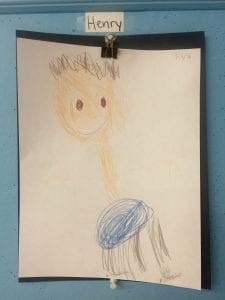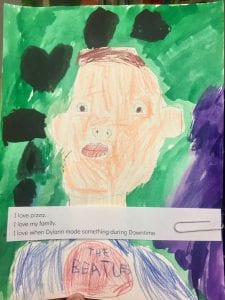I’m thinking a lot these days about a recurring project my son did in kindergarten. Every month, they drew a new self-portrait. With a small hand mirror and colored pencils in front of him, my son paused, observed, and drew what he saw. The drawings became more detailed over time, capturing things like skin tone, expression, clothing, and when looked at together they tell a kind of narrative: who my son was at a particular moment and who he was becoming, over time.
In my almost 14 years here at LREI, I have grown up as a teacher. I’m eager to reflect back on who I was when I began here, who I am now, and who I am becoming. I see this self study as a chance to examine my own kind of self-portraits, in order to assess not only where I am now, but where I am headed.
Below are a few paths this work could take.
Self Study Option 1: Bring My Writer to Work
November 2005. My first year at LREI. I’m in the car on the way back from a conference at Bard College with two colleagues when I nervously confess: I want to be a writer who teaches, not a teacher who writes. I have just graduated from my MFA program, and I clutch tightly to that idea. The distinction matters because it’s about priorities. Writing should be the driving force of my identity. Green with red spots vs. red with green spots. You see the difference.
But both identities are integral to who I am and who I want to be. Writing sustains me, as teaching does. Both are creative and personal and hard and thrilling. Both are always about more than just myself. I am a teacher (we know this job never stops, even in the summers). And I am a writer, even when I’m not writing. However, I haven’t found a way to do both, simultaneously. I carve out separate times for my writer self, in the summers mostly, and always outside the traditional space of “work.”
How I call myself matters less to me now. But it’s time for me to consider how I can nourish my writer self throughout the year, how both identities might coexist more, not just on special occasions or during summer break.
These two selves are connected more than I think. My teacher self informs what I value as a writer; my writer self informs what I value as a teacher. I am a writer who loves language and thus a teacher who loves language. Writing is a lens through which I see myself, the world, my students, the texts I teach, the assignments I craft. Yet, how might actively inhabiting my writerly self more consciously during the year, more intentionally, improve my teaching? How might I be more purposeful about modeling for my students my writerly lens, my writerly discipline? How can writing be a source that sustains me throughout the school year? What would it look like to carve out time and energy for my own writing work? How would my relationship to teaching, to students, to assessments shift?
Self Study Option 2: Public Purpose
November, 2018. I’m standing in the crowded 12th floor hallway of 26 Federal Plaza with four of my elective students. We’re waiting for our friend’s “alien number” to be called, so she can enter the court room for her hearing and we can accompany her inside. We know her name, but not much else. We have just met her that morning.
The students and I are participating in New Sanctuary Coalition’s accompaniment program, as part of a service learning project I’ve developed for my fall Exile and Immigration elective. The project took shape during the LREI Service Learning Lab, which I participated in over the summer of 2018.
Participating in accompaniments with my students has been one of the most exciting and engaging new endeavors of my teaching career. It has challenged me; it has challenged my students. And it is allowing me to articulate the work that I feel most passionate about.
Last year, the word most often out of my mouth might have been discourse. I was concerned about how I was facilitating meaningful discourse (not discussion, but real dialogue) in my classroom. How were students really talking to each other and constructing meaning together? This year, however, more than ever, I’m seeing how listening – meaningful, significant, true listening – is an overlooked skill key to rich, productive discourse.
Part of what the New Sanctuary accompaniments do is place us in the position of listener. The friends we accompany have stories we don’t know. We are not supposed to ask. It’s none of our business. In the courtroom, the students and I listen carefully, holding the system accountable. We listen to the judge, the lawyers, our friend, the interpreter. We listen for tone and nuance. We make observations, and then share our reflections with each other later. We learn a lot through listening – about immigration court, about policy, about individual experiences — and then we work to make sense of it all together. And we are learning that this listening, this bearing witness, is a powerful form of activism and social justice.
This year, I would like to think more about this service learning project, and specifically, the following questions:
- What are the ways I am engaging in ongoing meaningful service work personally?
- What can I learn about myself in the ways I participate in service, with New Sanctuary Coalition and beyond? How can I think about who I am as a listener?
- How can I help build this project forward/ grow it beyond this one class experience?
- How can I share this work with other colleagues, students, and community members?
- How can I nurture meaningful listening in all my students?
Self Study Option 3: The Greatest Hits
November, 2014. I’m organizing my desk, tidying up in preparation for my maternity leave. “You have a lot of binders,” a colleague tells me, “You save a lot of papers.” It’s true.
Over my time at LREI, I have developed countless new courses, units, and projects. Some of them have been independent, and some, like the redesign of the English 9-12 program, have been in collaboration with colleagues. Some of this work still exists (in new iterations, often), and some has been put aside or flat out discarded over the years.
I save mostly everything, however. I have notebooks, binders, and google doc drives full of iterations of projects and units and handouts. Mostly, they sit on dusty shelves above my desk. Every once in a while I’ll be compelled to search through them, because a colleague asks for a resource or I remember some germ of an idea that was beginning to take shape. Sometimes, it seems like that work exists in another life: What? I used to do a performance project with Macbeth? What? Students created set designs for Cat on the Hot Tin Roof? What? I used to teach a unit on Native American poetry?
The Kon-Mari-wannabe in me might say: Purge! Shred! Declutter! But the packrat/archivist in me gives me pause. What could I learn from these documents?
For this self study I would ask:
- What are some of my favorite projects/texts/ideas that I’ve preserved over the years and what are the favorites I’ve had to abandon for a variety of reasons?
- How have units and assessments changed over time?
- How might I learn from what I have kept and what I have let go? What would looking back at these documents indicate about how am I evolving as a teacher?
- What past ideas are ripe for exploring in new ways?
- What of my earlier teacher self would I want to recapture or reinvest in?
- What should I consider letting go of at this point in my career?






Jane, thanks for engaging in this work so purposefully. There is so much here into which you can dig. As we have discussed with the group, maybe it is helpful to look at these ideas as a metaphor to help you engage in the reflective work that is at the core of the self-study. In that light, if you think about the self-study as a way to “accompany” yourself, what stories emerge as you create the space to really listen? What is the story that emerges of the writer-teacher/teacher-writer that you have been and are becoming? Where might that story head as you look forward to the future? And in listening to and interrogating the past, what are the artifacts from your prior work that seem to be reaching out and looking for new stories to tell? I’m truly excited to see where this work takes you.